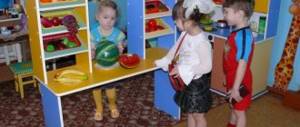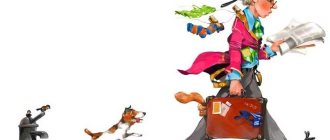Summary of an open lesson on gender education in the middle group “Magic Journey”
A magical journey.
Lesson on gender education for preschoolers
for the middle group.
Goals:
Educational:
systematize children’s knowledge that people are male and female (boys and girls). Promote the first manifestations of sexual identity based on signs such as clothing and hairstyle. Create favorable conditions for enriching, systematizing knowledge, ideas about the world around you and your own self (physical, mental and social). Learn to be creative in completing assigned tasks. Consolidate knowledge of primary colors: white, yellow, red, blue; composite - orange and complex - brown.
Developmental:
develop the ability to take into account specific gender characteristics during joint activities. Create favorable conditions for increasing self-esteem, exercise in overcoming difficulties. Develop the ability to control your body. Be guided by your appearance and the appearance of other children.
Educational:
contribute to the formation of a system of elementary values, a positive attitude towards people of the opposite sex. Foster a culture of children's desires. To form moral forms of relationships between boys and girls, to cultivate a culture of behavior. Introduce children to world culture through classical music. Learn to think, express and defend your opinion. To cultivate basic personality qualities: independence, humanity, observation, creativity.
Tasks for mastering educational areas.
Physical development:
develop motor activity, dexterity, dexterity. Support children's desire to perform playful movements, transforming into fairy-tale characters. Teach children the culture of body movements.
Social and personal development:
teach children to be guided in their behavior by moral standards, to offer help and support to each other. Develop the idea that boys and girls can do many useful things when they are friends.
Communication:
evoke in children an emotional response to problematic situations, teach them to respond adequately to pleasant and unpleasant life events, and value friendship and the attention of their friends. Cultivate respect for comrades and elders. Learn to correctly understand your gender role in society
Cognitive - speech development:
expand and enrich children’s ideas about objects and things that boys and girls use, people, themselves and the world around them. Exercise in examining objects, objects, people. Learn to distinguish colors and their shades, learn to listen and understand instructions for games, improve the sound pronunciation of “ch”, “zh”, “sh”. Enrich your vocabulary with nouns - names of items of clothing. Form a grammatical structure of speech, speak freely, smoothly, slowly. Use the phrase “because.” Teach children to compliment each other using comparative adjectives and adverbs (beautiful, strong, brave, gentle, graceful, the best, etc.).
Artistic and aesthetic development:
teach children to emotionally perceive classical music, feel its mood and beauty. To promote the development of mobility and dexterity, “immersing” the child in a variety of music, to educate and develop musical and aesthetic taste. To develop children’s ability to select and arrange figures of a boy and a girl in appropriate clothing, to prepare children to solve problem situations creatively and on their own. Encourage the generation of new ideas. Learn to ask for help from friends and adults without hesitation.
Preliminary work.
Conversations: “Boys are future men”, “Girls are future women”, “Boys are defenders of the weak”, “Girls are future mothers”, “Boys are gentlemen”, “Girls are little princesses”.
Didactic games: “Name it affectionately”, “Who is it?” (boy or girl).”
Plot-role-playing games: “Toy store”, “Dress the doll for a walk”.
Looking at the albums “Insects”, Spring Flowers”, “Summer Flowers”, “Autumn Flowers”.
Drawing beetles and butterflies. Fixing the names of the colors of the spectrum.
A game for developing trusting relationships “Pass it over the stream.”
Musically - ri.
Game exercise to develop communication skills “Pass the Heart.”
Listening and discussing works of classical music.
Equipment.
Music center, plasma TV, laptop. Recordings of classical works, slide shows. Red heart (soft toy), flannelgraph, blanket, letter. A piece of blue fabric to depict a stream, red sports mats (3 pcs.) for bridges, scarves. Caps of butterflies and beetles, flowers made of cardboard. Various toys for girls and boys: (cars, dolls, hairpins, toy tools, ribbons, etc.), two baskets for toys. Carpet designer, images of a girl and a boy, red and blue petals, red balloons for each child.
Progress of the lesson.
1.
Group presentation.
A song plays on music. Yu. Chichkova, lyrics. Ya. Khalemsky “What, what are our boys made of?”
A slide show with photographs of the group's children is shown on the screen.
2.
A fragment of the song by the group “Barbariki” “What is kindness?” plays, the children enter the hall and form a circle.
3.
Polylogue.
Educator: Guys, today we have an open lesson and we will show the guests how smart, beautiful, cheerful we are, how we can be friends. Now let's introduce ourselves to the guests.
5. The game “Pass the Heart” is played. Children pass a red heart to each other and call themselves: “I am Anechka, I am a girl; I am Dima, I am a boy.”
Educator: Well done! So we met. Guys, do you like to travel?
I invite you to visit a fairyland! Girls and boys live there, they are very close friends, they never offend each other or quarrel. Well, did you fly?
One, two, three, turn around and find yourself in a magical land! (To the sounds of G. Verdi’s melody from the opera “La Traviata,” the children slowly spin.)
A slide show “Magic Country” appears on the screen to the music “Dance of the Fairy Drazzhe” by P. I. Tchaikovsky. The show is accompanied by comments from the teacher.
Educator: Children, would you like to meet the inhabitants of this wonderful country? Let's hurry to meet the girl and the boy! What will we go on?
I know that you really like to ride the train. Take your seats quickly, our train is leaving!
Children stand one after another, forming a “train” and moving in a circle. On the screen is a screen saver of a moving train, music sounds in a modern arrangement of “Polovtsian Dances” by A. Borodin from the opera “Prince Igor” performed by Richard Clayderman.
Educator: Well, here we are! Look, our heroes live here. Attracts children's attention to the flannelgraph
.
He has a blanket on him
.
Dear heroes, come out! ( takes off the blanket, but there is no one there
). Guys, where are the girl and boy? You did not see? Look, there's some kind of letter here. Maybe they left it to us? Let's read it!
The teacher opens the letter and reads.
(Sounds like “Waltz of the Snowflakes” by P. Tchaikovsky from the ballet “The Nutcracker”).
“Hello, guys! What, you came to visit? No such luck! We, the evil sorceresses Yabeda, Kapriza and Vredina, decided to stop you! We made sure that the girls and boys of this country quarreled forever and left here. So if you want to get them back, you'll have to work hard. We have come up with such difficult tasks for you that you are unlikely to cope with them. But, if you are friendly, brave and determined, then you will be able to overcome all obstacles and bring back the little inhabitants of the magical land. Hello! Sneak, Caprice, Mischief."
Educator: Yes, guys, this is news! What do we do? We need to help children out of trouble! Do you think we will be able to complete the tasks of the evil sorceresses? Then let's read the first task: “Go to the stream.”
Hurry up and take your seats on the train, we are already leaving!
Music is playing. Children move in a circle, imitating the movement of a train.
The guys come up to the screen. There is a slide show “Ruchechok” to the music “Morning in the Forest” by Edvard Grieg from the “Peer Gynt” suite.
6. The game “Cross the stream” is played. ( The “Prelude” by J. - S. Bach sounds).
Rules: a boy takes a blindfolded girl across the bridges, then the girl takes the boy.
Goal: to teach children to lend their friendly shoulder in time, to trust each other, to develop empathy.
Educator: Well done, guys! You are so friendly! The boys were very caring and carefully translated the girls. And the girls were great too - they bravely led the boys across the bridge!
The teacher reads the following task for the sorceresses.
“Now go to the flower meadow!”
Music is playing. Children move in a circle, imitating the movement of a train.
On the screen of the sweet show “Flower Glade”. (The “Waltz of the Flowers” from the ballet “The Nutcracker” by P. Tchaikovsky sounds).
7. The game “Butterflies and Beetles” is played.
Rules: girls - butterflies easily and gracefully circle around the flower meadow to the music, gently pronouncing the sound “sh”. As soon as the music stops, they sit down by a flower of the same color as the rubber bands on their hands (2-3 times, children change rubber bands). The music used is “The Joke” by J. – S. Bach.
Then the beetle boys, stamping their feet, buzzing, perform the same task. The “Overture” from the opera “The Barber of Seville” by Gioachino Rossini in Spanish is used. Orchestra conducted by Paul Maria.
At the end of the game, girls and boys circle over the clearing
and sit down near the flowers, forming a pair . (Overture from the ballet sounds
“The Nutcracker” by P. I. Tchaikovsky).
Goal: to form in children the idea that girls are gentle, graceful, and graceful. And boys are strong and courageous. But they are all children who love to play and make friends. Learn to listen to music, capture its character, mood, move to the beat of the melody.
The teacher reads the following task for the sorceresses:
“Well, good!”
In the forest you completed the task, but in the city – we’ll see! We are waiting for you at the toy store!” Music is playing. Children move in a circle, imitating the movement of a train.
On the screen is a slide show “Toy Store”.
The music of V. Kosma from the film “Toy”
is playing Educator: Guys, look at the mess that Caprice, Yabed and Vredin left behind! All the toys are mixed up, you can’t understand anything - which boys play with and which girls play with... Let’s put things in order!
8. The game “Let’s sort out the toys” is played. "Minuet" by Luigi Boccherini is playing.
Rules: Various toys are laid out on the carpet. It is necessary to put toys for girls in a pink box, and for boys in a blue box. You need to name the toy loudly and say who likes to play with it - a boy or a girl.
Goal: to teach children to differentiate toys, justify their decision in choice, form the grammatical structure of speech, speak freely and fluently, use the phrase “because”.
Educator: Guys, you did a great job! All the toys are in their places, now our heroes will definitely not make a mistake with their choice. However, one more task awaits us. The sorceresses have called us on the road again! Now let's go to the clothing store!
Music is playing. Children move in a circle, imitating the movement of a train.
On the screen is a slide show “Clothing store».
The “Hungarian Dance” by J. Brahms is playing.
Educator: And evil sorceresses have been here! All the clothes were mixed up! Now you can’t figure out who should wear what? Well, how can we cope with the problem?
9. The game “Dress the doll ” is played.
“Spanish Polka” by S. Rachmaninoff is playing.
Rules: on the carpet constructor you need to assemble the image of a girl and a boy, choosing the right clothes for them.
Goal: to teach children to differentiate items of clothing, justify their decision in choice, form the grammatical structure of speech, speak freely and fluently, use the phrase “because”. Develop tactile sensations and fine motor skills.
Educator: Great, guys! All things are in order and in their places.
Reads the letter.
“If you guys completed this task, then
you are true friends. Only by feeling the support of a friend can one overcome all obstacles. It seems it's time for us to improve. Just don't know where to start? Maybe we should start by learning to say kind words to each other? Do you know what they are called?
Children: Compliments!
Educator: Guys, let's look at the screen and explain to the sorceresses how to give compliments correctly!
On the screen is a slide show “Compliments”. The teacher discusses the images with the children. Sounds like “Blizzard” by G. Sviridov.
Educator: So the tasks of the evil sorceresses are over! You overcame them so well that Kapriza, Vredina and Yabeda decided to follow your example and improve. Maybe they brought back the inhabitants of the magical land? Let's go quickly and have a look!
The children come up to the flannelgraph and see a girl and a boy there.
Polylogue.
Educator: Here they are, wonderful inhabitants of a magical land! Who is this? What are their names? You know that all girls and boys have names. What girls' names do you remember? What about boys? Let's name our heroes! Guys, look how elegant…….. and………….. are! Let's give them compliments!
10. The game “Compliment” is played.
Rules: children take turns taking red or blue petals from the table, saying a compliment ……… or………. And glue the petal onto the flannelgraph.
Target:
enrich children's vocabulary with adjectives and adverbs, teach them to speak easily and calmly, listen to what others say, not repeat themselves, develop communication skills.
Educator: Guys, our magical journey has ended! Today you and I have learned to trust each other even more, to live together, and not to let Snitch, Mischief and Caprice into our house. It's time to go home. I suggest flying in a hot air balloon. Close your eyes and listen to music, relax.
The melody “Fly away on the wings of the wind” by A. Borodin from the opera “Prince Igor” sounds.
Educator: Here we are at home! It's so nice here! Let's rejoice in our wonderful return and dance merrily!
The song of the group “Barbariki” “Friendship” is playing.
During the dance, children receive magical gifts - red balloons with a heart.






